
Lisa

Eric
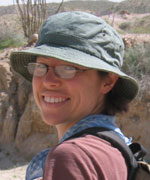
Skye

Greg

Frankel-Engles-Hudson-Thrush Botanical Expedition
Sonoran Desert, Anza-Borrego State Park
12-14 March 2005
Every once in awhile, the deserts put on a display of floristic fecundity that seems intended to show humans just how wrong they are to think of deserts as desolate and barren. With enough rain, they can out-flower any habitat on earth. Spring of 2005 is such a time. Many observers are calling the wildflower bloom the best they have ever seen--the best in our lifetimes.
The Sonoran Desert, the lowest in elevation and the most southerly, begins flowering first and often passes its peak by March. This year there were abundant blooms as early as December, and with the rains continuing through January and February, the flower season is stretching out over many months. The middle of March turns out to be an excellent time to visit: the annuals are still going strong in most locales, and the ocotillo and cactus are starting to bloom too.
Scroll down this page and read what interests you, and don't forget to view the trip slideshow.
 Lisa |
 Eric |
 Skye |
 Greg |
|
What We Did When
Saturday
9 am -- take off from Sacramento airport 10:45 am -- land in San Diego 1:30 pm -- exit I-8 in Ocotillo, CA 1:45-3:30 -- various roadside stops and jaunts 4-6:30 -- hike to main palm grove at Mountain Palm Springs 7 pm -- set up camp at Vallecito County Park Sunday
10 am -- drive north 11 am -- stop at Box Canyon 11:30 pm -- begin hike into Smuggler's Canyon 2:30 pm -- lunch in Blair Valley 3-4 -- set up camp at Agua Caliente Co. Park 4-6:30 -- hike Moonlight Canyon trail Monday
9 - 10:30 am -- hike part of Moonlight Canyon trail 10:30-11:45 am -- break camp and then head south noon - 3 pm -- hike Canyon Sin Nombre 3 -- leave for San Diego 6 - 7 pm -- dinner at Thai restaurant in Gaslamp district 7:30 pm -- arrive San Diego airport 11 pm -- arrive Sacramento airport |
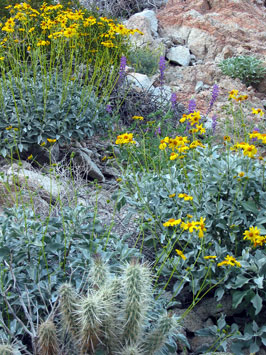
|
|||||||||||||
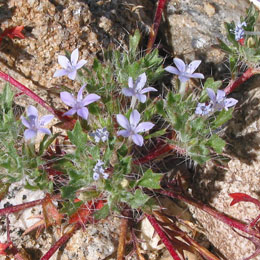 bristly langloisia |
Plants new to us (or newly identified)
Langloisia setosissima ssp. setosissima [Polemoniaceae] bristly langloisia
Lyrocarpa coulteri var. palmeri [Brassicaceae] Coulter's lyrepod (uncommon) Asclepias albicans [Asclepiadaceae] white-stemmed milkweed Antirrhinum filipes [Scrophulariaceae] twining snapdragon Allionia incarnata [Nyctaginaceae] trailing four-o'clock Hibiscus denudatus [Malvaceae] pale face Lycium fremontii [Solanaceae] Fremont's box-thorn And we saw many plants we didn't get a chance to key out or otherwise identify: a Solanaceous (?) shrub, an aster, a Polemone that was probably a Gilia, various Phacelias (some of which we had probably seen before), several Camissonias and Oenotheras, a widespread little pink Mimulus (bigelovii?), several Eriogonums and a probable Chorizanthe, an Emmenanthe (penduliflora?), and many more. |
|||||||||||||
|
Insects
Where there are flowers and leaves there are the insects that eat them,
and the insects that eat those insects. The brittlebush attracted mobs of butterflies, and we saw many
dung beetles, green larvae crawling across the sand, and various other odd and beautiful bugs.
|
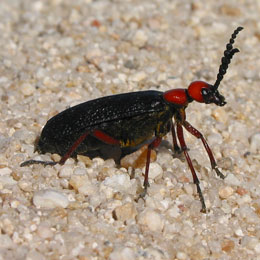 This regal creature was about 1.5 inches long |
 One of the abundant butterflies |
||||||||||||
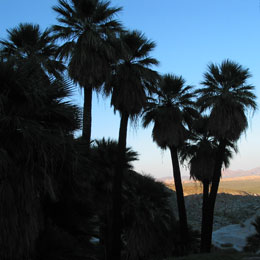 |
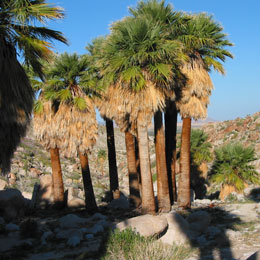 |
Palm Oases
There are dozens of palm oases in the park, most tucked into mountain canyons.
We hiked through several small ones to the one large one in Mountain Palm Canyon.
The palms are native to California, and more than 10,000 years ago, when the climate
was wetter, they were more widespread. Now they are restricted to isolated groves at springs and seeps.
At the big oasis, we found canyon tree frogs (?) in a small pool of water.
|
||||||||||||
|
Cacti
The cacti were just starting to bloom. We saw barrel cactus, nipple cactus,
cholla, and rabbit ears in flower. Only the hedgehog cactus were not yet flowering. The cholla stems
were amazingly fat with water.
|
 Mammalaria, or nipple cactus |
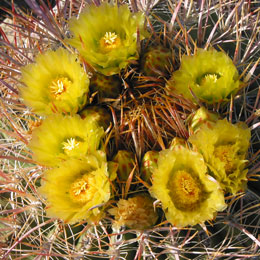 barrel cactus (Ferocactus) |
||||||||||||
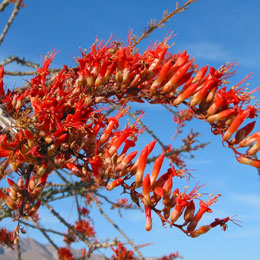 Clusters of waxy ocotillo flowers |
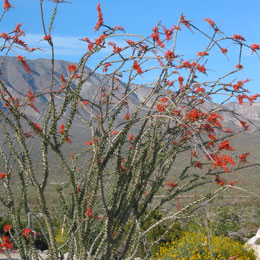 The whips are leafy only when the soil has moisture |
Ocotillo
Oh ocotillo! These are the signature plants of the lower Colorado part of the Sonoran desert. They are tall,
odd-looking, and absolutely beautiful when leafed out and blooming. The crimson flower clusters tip
the spiny whips like flames. We were lucky enough to arrive after many plants had begun to flower.
|
||||||||||||
|
Native People
Several groups of California Indians inhabited the area, including, most recently, the
Kumeyaay and the Cahuilla. On our
hike into Smuggler's Canyon, we found one boulder covered with orange and yellow pictographs, and several
other boulders with mortars. In all, we saw about three dozen mortars. There must have been
a good food supply in the area--perhaps the seeds of some of the wildflowers.
|
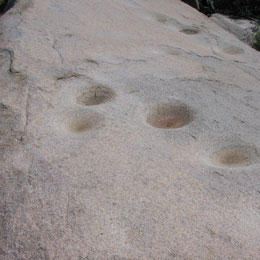 boulder covered with mortars |
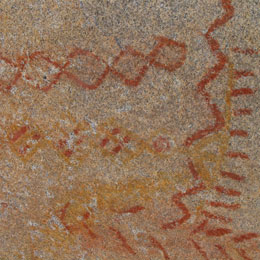 very nice pictographs |
||||||||||||
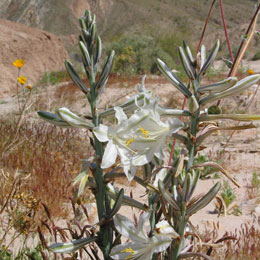 Desert lily, Hesperocallis undulata |
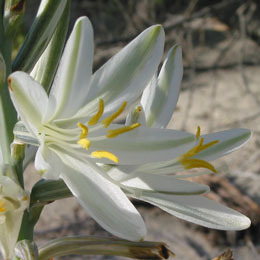 The pure white flowers are about 3 inches long |
Desert Lilies
Desert lilies are geophytes, bulb-bearing plants that pop up leaves and flower stalks when conditions
are right. In a typical year, most desert lily bulbs don't get enough moisture to send up flower stalks,
and in drought years, none appear at all. So they are fairly uncommon sights. This year,
all the mature desert lilies are blooming, and the young ones
are leafing out and building up energy reserves in their bulbs. We walked through many areas where lilies were
were blooming in profusion, with perhaps two dozen or more concentrated in a 20-foot diameter circle.
|
||||||||||||
|
Floriferous Hillsides
The places we went didn't have the vast expanses of flower fields that
are occuring this spring in Death Valley, but they did have large patches of dense flowering shrubs and annuals
with high diversity,
creating lovely rock gardens full of different colors. Huge, mostly monochromatic, homogenous seas of flowers
are impressive, but heterogenous, polychromatic arrays of flowers, shrubs, and cactus are more interesting and
inspiring.
|
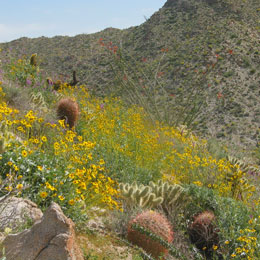 |
 |
||||||||||||
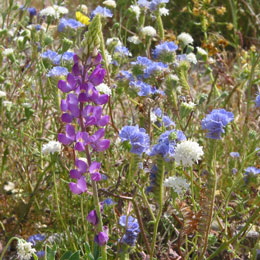 |
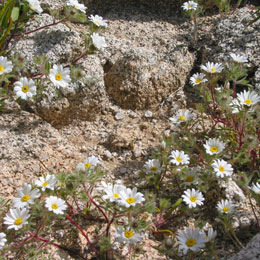 |
The Medium-scale World
Everywhere we walked the landscape offered medium-scale compositions of color, texture, light and dark.
This is the yard-wide expanse of the butterfly's world. For the human observer, it is endlessly
varied.
|
||||||||||||
|
The Micro-scale World
Cactus spines, leaf surfaces, insects, colored stones, individual flowers,
and endless other treasures invite you to observe the micro-scale architecture of the natural world.
|
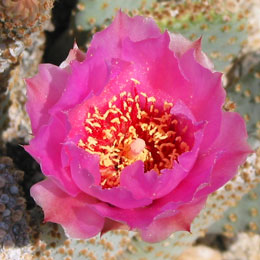 |
 |
||||||||||||
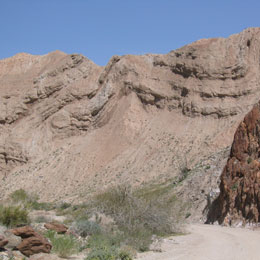 Canyon Sin Nombre |
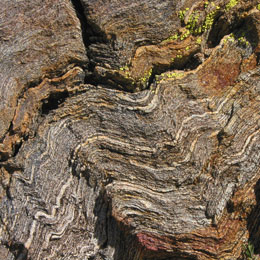 Box Canyon |
Geology
The desert offers up the earth's underlying structure--layering, folding, faults--for easy viewing, unobscured by
deep soil and thick vegetation.
|
||||||||||||
|
Eating and Sleeping
We had sumptuous dinners (Thai noodles and a rice/veggie/chicken/gravy stew) cooked on
a backpacking stove, and ate our lunches (salami, tomatoes, cheese, chocoate, nuts, apples) on granite tables.
Our campsites were pleasant and quiet. Agua Caliente County Park (Sunday night) had a hot-spring-fed pool,
but it wasn't open during the hours we weren't hiking.
|
 Campsite at Agua Caliente |
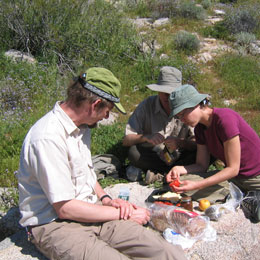 Lunch in Blair Valley |
||||||||||||
 Smuggler's Canyon |
Carpets
In Smuggler's Canyon (higher elevation) there were carpets of yellow composites between the shrubs. In Blair Valley,
filaree played the same role.
|
|||||||||||||
|
Nature's Art
The desert abounds with works of art, from living sculpture like this Dudleya to
rock-garden arrangements.
|
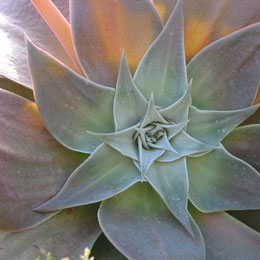 Dudleya sp. |
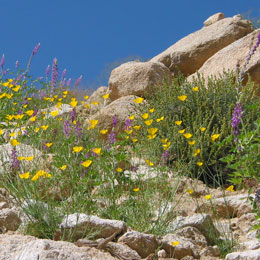 desert poppies, Arizona lupines, and granite |
||||||||||||
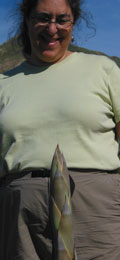
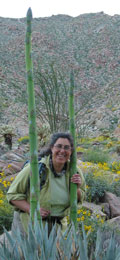
|
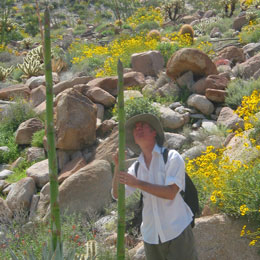 |
Fun with Agaves
The turgid young flower stalks of many agave were thrusting forth toward the sky, looking
like giant asparagus. It seemed that you could see them growing if you watched carefully enough.
|
||||||||||||
|
Trip Cost
It was a very affordable vacation!
|
 Delphinium parishii |
|||||||||||||
|
To see more photos (at higher resolution), view the trip slideshow. | ||||||||||||||
 | ||||||||||||||